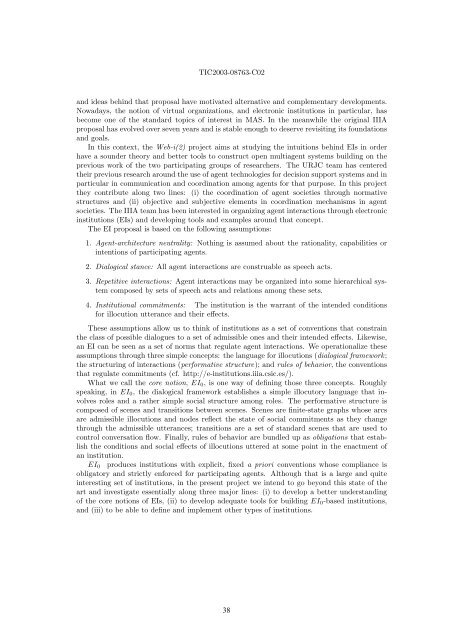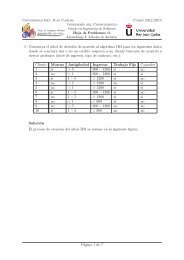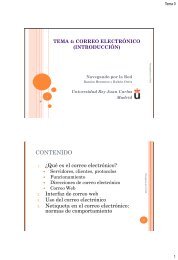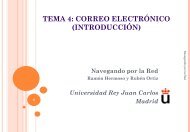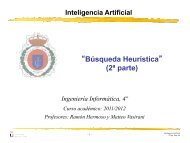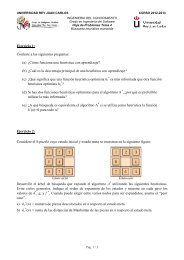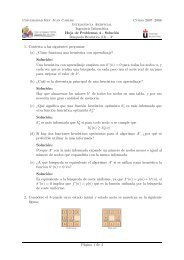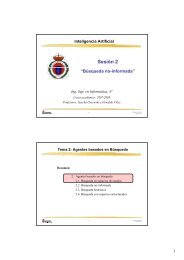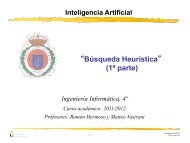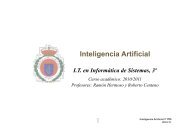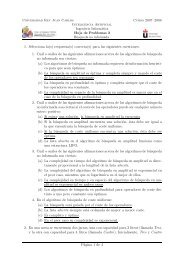GLIRS-II - Grupo de Inteligencia Artificial - Universidad Rey Juan ...
GLIRS-II - Grupo de Inteligencia Artificial - Universidad Rey Juan ...
GLIRS-II - Grupo de Inteligencia Artificial - Universidad Rey Juan ...
You also want an ePaper? Increase the reach of your titles
YUMPU automatically turns print PDFs into web optimized ePapers that Google loves.
TIC2003-08763-C02<br />
and i<strong>de</strong>as behind that proposal have motivated alternative and complementary <strong>de</strong>velopments.<br />
Nowadays, the notion of virtual organizations, and electronic institutions in particular, has<br />
become one of the standard topics of interest in MAS. In the meanwhile the original <strong>II</strong>IA<br />
proposal has evolved over seven years and is stable enough to <strong>de</strong>serve revisiting its foundations<br />
and goals.<br />
In this context, the Web-i(2) project aims at studying the intuitions behind EIs in or<strong>de</strong>r<br />
have a soun<strong>de</strong>r theory and better tools to construct open multiagent systems building on the<br />
previous work of the two participating groups of researchers. The URJC team has centered<br />
their previous research around the use of agent technologies for <strong>de</strong>cision support systems and in<br />
particular in communication and coordination among agents for that purpose. In this project<br />
they contribute along two lines: (i) the coordination of agent societies through normative<br />
structures and (ii) objective and subjective elements in coordination mechanisms in agent<br />
societies. The <strong>II</strong>IA team has been interested in organizing agent interactions through electronic<br />
institutions (EIs) and <strong>de</strong>veloping tools and examples around that concept.<br />
The EI proposal is based on the following assumptions:<br />
1. Agent-architecture neutrality: Nothing is assumed about the rationality, capabilities or<br />
intentions of participating agents.<br />
2. Dialogical stance: All agent interactions are construable as speech acts.<br />
3. Repetitive interactions: Agent interactions may be organized into some hierarchical system<br />
composed by sets of speech acts and relations among these sets.<br />
4. Institutional commitments: The institution is the warrant of the inten<strong>de</strong>d conditions<br />
for illocution utterance and their effects.<br />
These assumptions allow us to think of institutions as a set of conventions that constrain<br />
the class of possible dialogues to a set of admissible ones and their inten<strong>de</strong>d effects. Likewise,<br />
an EI can be seen as a set of norms that regulate agent interactions. We operationalize these<br />
assumptions through three simple concepts: the language for illocutions (dialogical framework;<br />
the structuring of interactions (performative structure); and rules of behavior, the conventions<br />
that regulate commitments (cf. http://e-institutions.iiia.csic.es/).<br />
What we call the core notion, EI0, is one way of <strong>de</strong>fining those three concepts. Roughly<br />
speaking, in EI0, the dialogical framework establishes a simple illocutory language that involves<br />
roles and a rather simple social structure among roles. The performative structure is<br />
composed of scenes and transitions between scenes. Scenes are finite-state graphs whose arcs<br />
are admissible illocutions and no<strong>de</strong>s reflect the state of social commitments as they change<br />
through the admissible utterances; transitions are a set of standard scenes that are used to<br />
control conversation flow. Finally, rules of behavior are bundled up as obligations that establish<br />
the conditions and social effects of illocutions uttered at some point in the enactment of<br />
an institution.<br />
EI0 produces institutions with explicit, fixed a priori conventions whose compliance is<br />
obligatory and strictly enforced for participating agents. Although that is a large and quite<br />
interesting set of institutions, in the present project we intend to go beyond this state of the<br />
art and investigate essentially along three major lines: (i) to <strong>de</strong>velop a better un<strong>de</strong>rstanding<br />
of the core notions of EIs, (ii) to <strong>de</strong>velop a<strong>de</strong>quate tools for building EI0-based institutions,<br />
and (iii) to be able to <strong>de</strong>fine and implement other types of institutions.<br />
38


